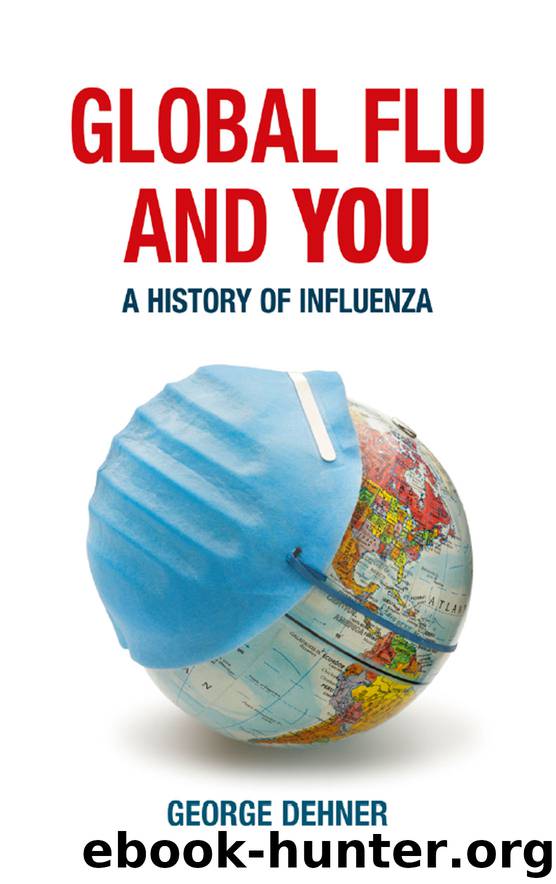Global Flu and You by George Dehner

Author:George Dehner
Language: eng
Format: epub
Publisher: Reaktion Books
The Swine Flu of 1976
In early January 1976, a mini outbreak of a respiratory disease broke out at a military camp in New Jersey.49 Subsequent testing determined that the sicknesses were caused by a novel influenza strain and that the infection had been surprisingly widespread in the camp, although the outbreak had died out and no cases outside the camp had been detected. Perhaps most ominously, the new strain was type H1SWN1, and testing revealed that it was closely related, but not identical, to swine flu samples from 1930 (gathered by Richard Shope): the presumed descendant of Spanish flu. Both United States health officials and health officials from the WHO were immediately alarmed. The virus was new and had serially transmitted between humans on the base. But the outbreak had stopped and no other cases had been found anywhere around the globe. What was one to make of it? Was it an emerging pandemic or not?
In the United States, mindful of how rapidly the preceding pandemics had outstripped vaccine production, health officials began to lobby for a large-scale vaccination campaign to protect the public. The U.S. had the manufacturing capacity and had been preparing for the next pandemic. The key, they believed, was quick decision-making and getting ahead of an emerging epidemic. Accordingly, in late March 1976, in the absence of any additional evidence, U.S. president Gerald Ford announced that he was requesting that Congress authorize a program to vaccinate every American man, woman, and child. Vaccine manufacturers went into overdrive, seeking to produce around 200 million doses to offset a potential fall and winter pandemic of Swine flu (as the strain was dubbed).
WHO officials, who had also been involved in preparing for a potential influenza pandemic in the years following the appearance of Hong Kong flu, faced a different set of challenges than the United States health officials. The WHO had no vaccine-producing facilities, and it represented a number of states who also lacked the productive resources to mount large-scale vaccine operations. Worse, many of these states had previously purchased the vaccines they did use on a yearly basis from U.S.-based pharmaceutical houses. The U.S. government had now ordered the entire production run of these manufacturers, which meant there would be little vaccine available on the international market. As U.S. health officials accelerated to their decision to mount a national vaccine program, WHO officials began to find the evidence that did not support a pandemic more compelling. Ultimately, the WHO would recommend to its member states that national health programs should continue to monitor the situation, but do little beyond that. In the end, a few states created a small stockpile of protective vaccines, but only Canada undertook serious efforts to develop widespread protective inoculation programs.
When the fall of 1976 came, and with it the traditional onset of influenza season across the northern hemisphere, there was no pandemic of Swine flu. Indeed, there was very little influenza at all. The fall of 1976 was a very mild influenza season.
Download
This site does not store any files on its server. We only index and link to content provided by other sites. Please contact the content providers to delete copyright contents if any and email us, we'll remove relevant links or contents immediately.
Periodization Training for Sports by Tudor Bompa(8171)
Why We Sleep: Unlocking the Power of Sleep and Dreams by Matthew Walker(6618)
Paper Towns by Green John(5092)
The Immortal Life of Henrietta Lacks by Rebecca Skloot(4526)
The Sports Rules Book by Human Kinetics(4296)
Dynamic Alignment Through Imagery by Eric Franklin(4118)
ACSM's Complete Guide to Fitness & Health by ACSM(3989)
Kaplan MCAT Organic Chemistry Review: Created for MCAT 2015 (Kaplan Test Prep) by Kaplan(3940)
Introduction to Kinesiology by Shirl J. Hoffman(3726)
Livewired by David Eagleman(3685)
The Death of the Heart by Elizabeth Bowen(3553)
The River of Consciousness by Oliver Sacks(3542)
Alchemy and Alchemists by C. J. S. Thompson(3451)
Bad Pharma by Ben Goldacre(3357)
Descartes' Error by Antonio Damasio(3230)
The Emperor of All Maladies: A Biography of Cancer by Siddhartha Mukherjee(3068)
The Gene: An Intimate History by Siddhartha Mukherjee(3048)
The Fate of Rome: Climate, Disease, and the End of an Empire (The Princeton History of the Ancient World) by Kyle Harper(3003)
Kaplan MCAT Behavioral Sciences Review: Created for MCAT 2015 (Kaplan Test Prep) by Kaplan(2941)
